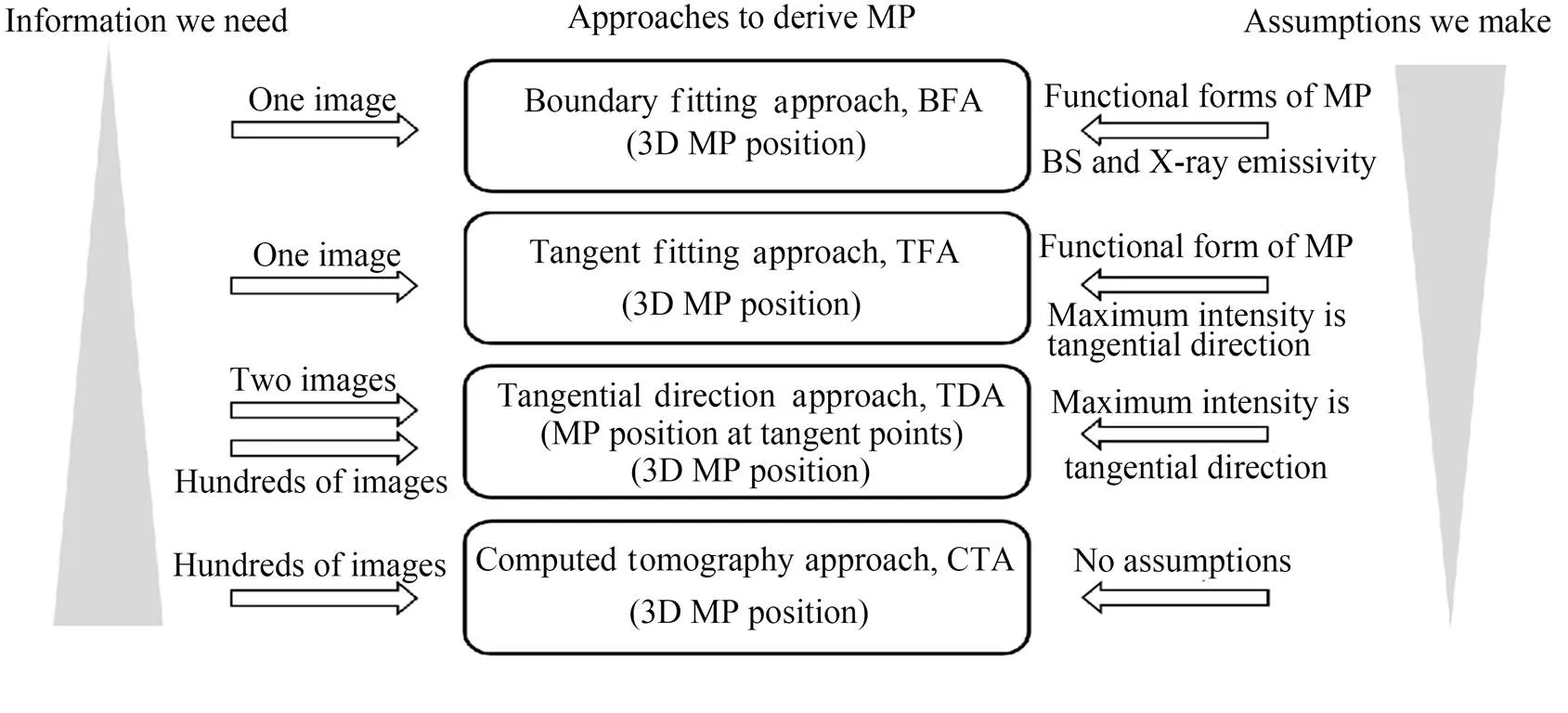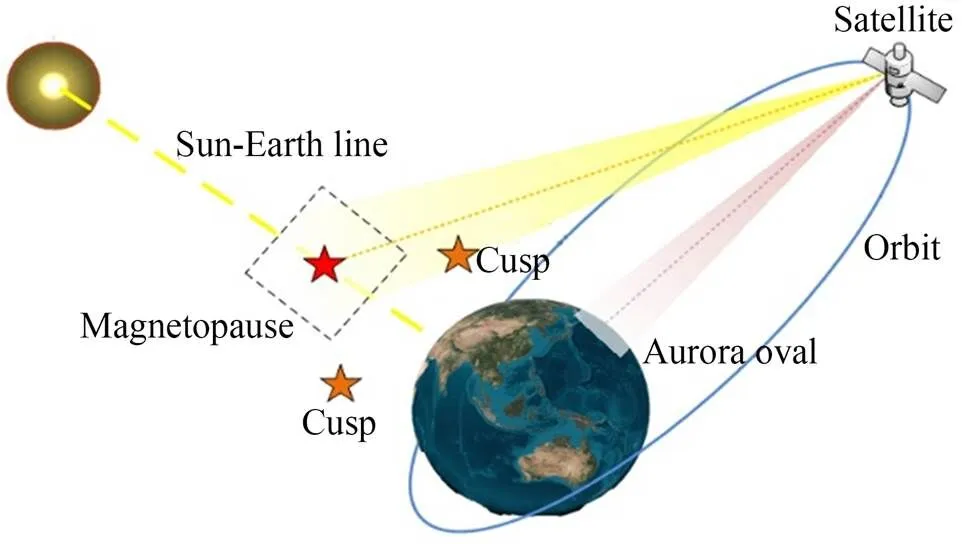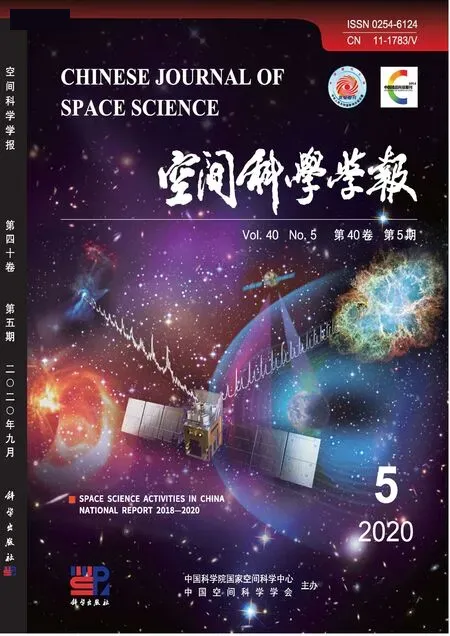Update on the ESA-CAS Joint Solar Wind Magnetosphere Ionosphere Link Explorer (SMILE) Mission*
2020-04-16WANGChiBRANDUARDIRAYMONTGraziella
WANG Chi BRANDUARDI-RAYMONT Graziella
Update on the ESA-CAS Joint Solar Wind Magnetosphere Ionosphere Link Explorer (SMILE) Mission*
WANG Chi1BRANDUARDI-RAYMONT Graziella2
1 (100190) 2 ()
The SMILE (Solar wind Magnetosphere Ionosphere Link Explorer) mission aims at deepening our understanding of the interaction of the solar wind with the Earth magnetosphere. It is the first time that ESA and CAS jointly select, design, implement, launch, and operate a space mission. The mission was adopted by CAS in November 2016 and by ESA in March 2019 with a target launch date by the end of 2023.
SMILE, Soft X-ray Imager (SXI), Ultra-Violet Imager (UVI), Light Ion Analyzer (LIA), MAGnetometer (MAG)
1 Introduction
The SMILE (Solar wind Magnetosphere Ionosphere Link Explorer) mission was proposed as a candidate in response to the ESA and CAS (Chinese Academy of Sciences) joint call for a small class mission released in January 2015. SMILE aims at deepening our understanding of the interaction of the solar wind with the Earth magnetosphere by making global images of the dayside magnetosheath and cusps of the magnetosphere, and the aurorae at the North Pole simultaneously, while monitoring the in-situ plasma environment. Following the recommendation of the joint Scientific Evaluation Panel, SPC reached the consensus to select SMILE in November 2015, with a target launch date by the end of 2023. The mission was adopted by CAS in November, 2016 (the 13th Five-Year Plan Period) and by ESA in March 2019.
It is the first time that ESA and China jointly select, design, implement, launch, and operate a space mission. CAS is responsible for the study and development of satellite Platform (PF), TC/TM (CLTC), Science Application System (SAS) as well as Ground Support System (GSS), and provides in-situmeasurement instruments MAGnetometer (MAG) and Light Ion Analyzer (LIA). While ESA is responsible for the study and development of Payload Module (PLM), Launch Vehicle, Launch Site, and science operation and ground receiving station supports when necessary, and also the development of the Soft X-ray Imager (SXI) and Ultra-Violet Imager (UVI).
2 Scientific Objectives
As pointed out by the ESA/CSA Joint Scientific Evaluation Panel, the SMILE Mission will use novel soft X-ray imaging technology to obtain, for the first time, the global image of the solar wind-magneto-sphere ionosphere interaction. This is critical to quantitatively analyzing and understanding of the global feature of the solar-terrestrial system.
Understanding and thus predicting the non-linear global systematic behaviours of the magnetosphere have remained both the key objectives and grand challenges of the solar-terrestrial physics in particular for more than 50 years. In-situ data has dramatically improved our understanding of the localized physical processes involved. However, piecing the individual parts together to make a coherent overall picture, capable of explaining and predicting the dynamics of the magnetosphere at the system level has proved to be extremely difficult. Remote sensing of the cusps and magnetosheath with X-ray imaging is now possible thanks to the relatively recent discovery of the solar wind charge exchange (SWCX) X-ray emission. Based on this mechanism, SMILE’s Soft X-ray Imager (SXI) can be used to determine the nature of the dayside solar wind- magnetosphere interaction from conditions prevailing at the Earth’s bow shock, magnetopause, and cusps. The system-level magnetospheric dynamics can be further sensed via time sequences of auroral images, which can be provided by SMILE’s high-heritage Ultraviolet Imager (UVI). Therefore, SMILE is a novel space mission that will revolutionize the magnetospheric physics by providing simultaneous images and movies of the magnetopause, cusps, and auroral oval using state-of-the-art detection techniques.
The interaction of the solar wind with the Earth’s atmosphere leads to the formation of the large-structures of the magnetosphere, including the bow shock, magnetopause, and cusp regions. The position and shape of the magnetopause and cusps change constantly as the Earth’s magnetosphere responds to varying solar wind dynamic pressures and interplanetary magnetic field orientations. Both the fast and slow solar wind can be interrupted by large, fast-moving bursts of plasma called interplanetary Coronal Mass Ejections (CMEs). When a CME impacts the Earth’s magnetosphere, it temporarily deforms the Earth's magnetic field, changing its direction and strength, and induces large electrical currents; this is called a geomagnetic storm and it is a global phenomenon. The southward interplanetary magnetic fields, as presented in a CME event, could induce magnetic reconnection in the Earth’s magnetotail; this launches protons and electrons downward toward the Earth’s atmosphere, where they form the aurora, resulting in substorms.
The Science objectives of SMILE mission are summarized as: (i) explore the fundamental modes of the dayside solar wind/magnetosphere interaction; (ii) understand the substorm cycle; (iii) determine how CME-driven storms arise and their relationship to substorms.
3 Modeling Update
The solar wind-magnetosphere interaction can be modeled by global MHD codes. Figure1 is the SXI intensity simulation result during a magnetic storm event on 17 Mar 2015, based on the 3D PPMLR (the extended Lagrangian version of the piecewise parabolic method) MHD code. The left panel shows the time variation of solar wind parameters and theindex. From top to bottom, the parameters are: interplanetary magnetic field, plasma velocity, number density, temperature, and. The orbit of SMILE is plotted in the middle panel. The right panel presents the simulated X-ray image, with the white box showing the field of view of SXI. The crescent-shaped region with relatively high X-ray emission provides information about the magnetopause boundary position, important to the study of system-level magnetospheric dynamics.
To extract location and motion of the dayside boundaries such as bow shock, magnetopause, low- and high-latitude cusp boundaries from X-ray images, the SMILE Modelling Working Group (MWG) performs studies on the reconstruction techniques. So far, four approaches have been developed to derive the 3D magnetopause position from X-ray images, namely the Boundary Fitting Approach (BFA), Tangent Fitting Approach (TFA), Tangential Direction Approach (TDA), and Computed Tomography Approach (CTA). These approaches are developed based on different assumptions about the shapes of boundaries or features of the X-ray emissions, and preliminary model studies show that they work well with desired X-ray information provided. Figure2 is a brief summary of the reconstruction approaches.

Fig.1 MHD simulation of the X-ray intensity

Fig.2 Current approaches to derive the magnetopause position from X-ray images
4 Mission Overview
4.1 Satellite System
Satellite orbit has a big inclination and the highly elliptical orbit has an apogee altitude of about 19eand perigee of about 5000 km. The inclination is 70° if launched with Vega-C as baseline, or 98.0° if launched with Ariane 62.
The SMILE satellite system is constituted by Platform (PF) and Payload Module (PLM), and is a three-axis stabilized satellite. The mass of the satellite is less than 2250 kg. X-band transmission will meet CCSDS standard, with data rate 65 Mbit·s–1and data volume 35.5 Gbit per orbit. Telemetry and telecommand will be Unified S-band TT&C system. The lifetime will be more than 3 years after delivered to user.

Fig.3 SMILE satellite HEO orbit

Fig.4 Diagram of satellite structure
4.2 Launch Vehicle
Launch Vehicle is ESA’s responsibility. The options include single launching with Vega-C as baseline, or dual launching with Ariane 62 at Kourou.
4.3 Launch Site
ESA is responsible for the Launch Site and Launch service, and will provide the ground segment support and logistics.
4.4 TC/TM
China Satellite Launch and Tracking Control General(CLTC) will be responsible for the TC/TM of SMILE satellite. European Space Operation Center (ESOC) will be responsible for the TC/TM before the satellite separation with Launch Vehicle. In addition, ESA will also provide the support of ground station in case of emergency.
4.5 Ground Support System (GSS)
GSS has been constructed during the 12th Five-Year Plan Period and it will undergo some modifications according to the new requirements of the space science missions during the 13th Five-Year Plan Period. It is mainly responsible for the operation and management of the payloads, scientific data receiving,0data processing, data archiving of different levels, and distribution service of scientific data to the science community.
4.6 Science Application System (SAS)
CAS will set up SAS located at NSSC, and ESA will set up Science Operation Center (SOC) located in European Space Astronomy Center (ESAC). Both parties will cooperate coordinately to make a science strategic plan and observation plan, monitor the execution of the plan, analyze the performance of the payloads in orbit, implement the calibration of the payloads, produce quick look scientific data, and produce L1 and above scientific data products.
5 Development Plan and Current Status
The CAS part of the SMILE mission has already been adopted by Bureau of Major Research and Development (BMRD) in November 2016. After SMILE was selected by SPC in November 2015, the ESA part of the SMILE mission proceeded into Phase A study. SMILE mission has already completed Instrument Consolidation Review, PF, and PLM Consolidation Review in 2017. Joint Mission Consolidation Review (MCR) was completed in October 2018, which was the first joint review of the SMILE mission. SMILE mission passed through ESA mission adoption in March 2019 and went into Phase B study. With the effort of CAS and ESA study and engineering team, Joint Ground Segment Preliminary Design Review (PDR) was completed in October 2019. Based on Payload Instrument PLM and PF PDRs, the joint Mission PDR was completed successfully in January 2020 in Europe, which is the third joint review of the SMILE mission, marking the kick-off of Phase C. The next milestone will be the Mission Critical Design Review (CDR) scheduled in August 2021.
Acknowledgments SMILE Mission is a joint project with the support from CAS and ESA. Thanks for the great support of CAS Strategic Priority Research Program and the ESA science program. Also thanks to the study and engineering teams for their cooperation and hard work: National Space Science Center, Innovation Academy for microsatellites of CAS, CLTC, Shanghai Institute of Space Propulsion, National Center for Space Weather, Polar Research Institute of China,. from Chinese side; University College London, University of Leicester, Imperial College, University of Calgary, Rutherford Appleton Laboratory, Finnish Meteorological Institute,. from ESA side, as well as Canadian Space Agency and NASA Goddard Space Flight Center.
[1] SUN T, WANG C, CONNOR H K,. Deriving the magnetopause position from the soft X-ray image by using the tangent fitting approach [J]., 2020, 125. doi.org/10.1029/2020JA028169
P 35
WANG Chi, BRANDUARDI-RAYMONT Graziella. Update on the ESA-CAS Joint Solar Wind Magnetosphere Ionosphere Link Explorer (SMILE) Mission., 2020, 40(5): 700-703. DOI:10.11728/cjss2020.05.700
* Supported by Strategic Priority Program on Space Science, CAS(XDA15350000), National Natural Science Foundation of China (41731070), Key Research Program of Frontier Sciences, CAS(QYZDJ-SSW-JSC028), and Strategic Pionner Program on Space Science, CAS(XDA15052500)
February 2, 2020
E-mail: cw@spaceweather.ac.cn
